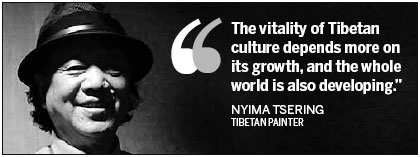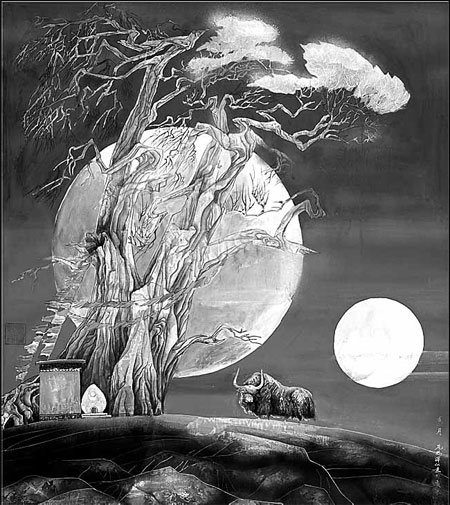Tibetan artist nurtures his culture
Updated: 2013-06-16 07:38
By Sun Yuqing in Sydney(China Daily)
|
|||||||
|
Nyima Tsering incorporates traditional Tibetan cultural elements, such as colors, forms and aesthetic styles, into his art. Photos Provided to China Daily |

Tibetan painter Nyima Tsering enjoys telling reporters they can ask him any questions they like about Tibet.
"I am ready to share my answers no matter how tough the questions seem to be," Nyima Tsering says during his paintings' tour in Australia.
Culture is in a process of constant evolution and engagement with other cultures, and there's no hope for any culture in the world that get stucks in the past or closes itself to the outside world, he told reporters in Sydney.
"I can understand that some people appreciate more the primitive flavor of the Qinghai-Tibet Plateau, but the vitality of Tibetan culture depends more on its growth, and the whole world is also developing."
He says that many Han people are now in Tibet, and many Tibetans, including artists like himself, work or create art in Beijing and other cities.
Nyima Tsering emphasized that the problems that Tibetan culture faces today are a reflection of China's urbanization and globalization.
"Among 56 ethnic groups in China, Tibetans and Naxi (ethnic group) actually have best maintained their distinctive cultural identity and arts. Many art forms of Han people are facing a loss of audience, and there are many once powerful nomadic peoples whose culture disappeared in China's history," he says.
After growing up in Dege county in the Garze Tibetan autonomous prefecture in Sichuan province, Nyima Tsering received professional training in painting at the Sichuan Academy of Fine Arts in 1958 and returned to his hometown in 1962 after graduation.
"My Han teacher told me that no scientific knowledge of fine arts you have learned can replace the Tibetan ethnicity," he says. "It is the core source of a Tibetan painter."
Lamaseries, folk artists, murals and thangka paintings all enriched Nyima Tsering's works that were exhibited in many countries.
He also shares stories about the painting show in New Delhi, India, where Tibetans living in India were impressed by the authenticity of his Tibetan paintings. Nyima Tsering believes that he can best explore and protect Tibetan ethnic culture in China.
"Great changes have happened in Tibetan areas," he tells foreign audiences. He insists on wearing a typical Tibetan hat when meeting with photographers, saying it an important part of his cultural exclusivity. But he seemed tolerant enough when talking about the popularity of Western clothes among young Tibetan people.
"Tibetans should be open-minded to technology. Living Buddhas in remote areas spread CDs about expounding the teachings of Buddhism, and there are also electric prayer wheels nowadays."
Nyima Tsering is happy Tibetan painting has changed from being a purely religious art form restricted to the lamaseries to a broader genre reflecting common people's lives since the 1990s.
"Tibetan Buddhism values high life, advocates every living creature is equal, and in my paintings I also try to present that mountains also experience the cycle of life," he says.
"We should draw strength from traditional Tibetan cultural elements, such as colors, forms and aesthetic styles, to turn them into a kind of art language that can be better appreciated by the international audience," Nyima Tsering says.
sunyq@chinadaily.com.cn
(China Daily 06/16/2013 page4)
